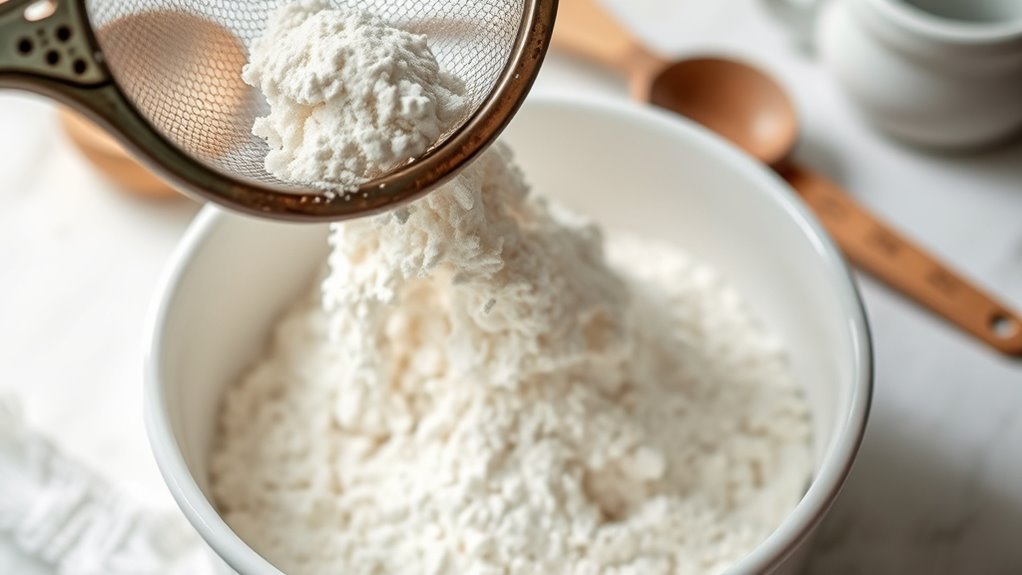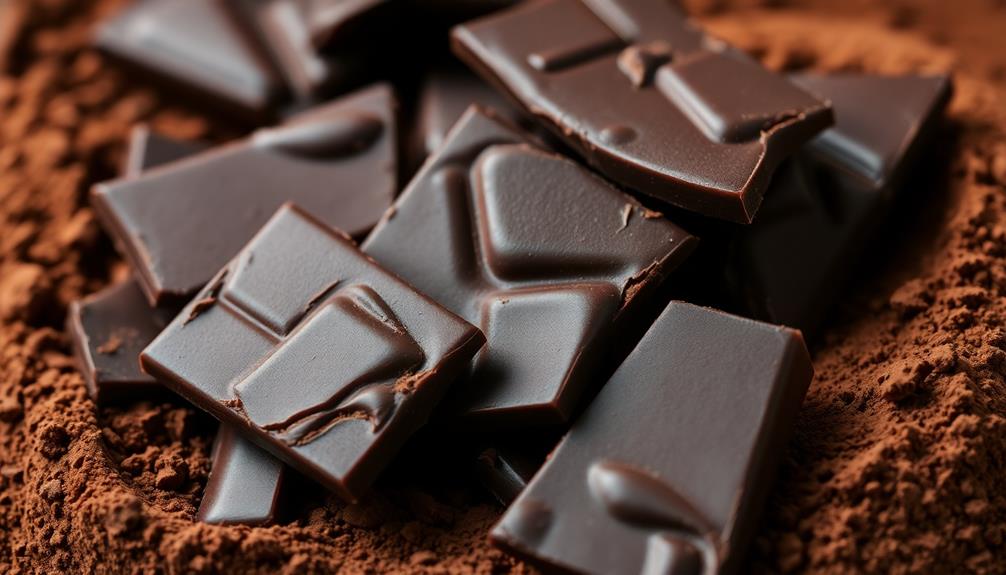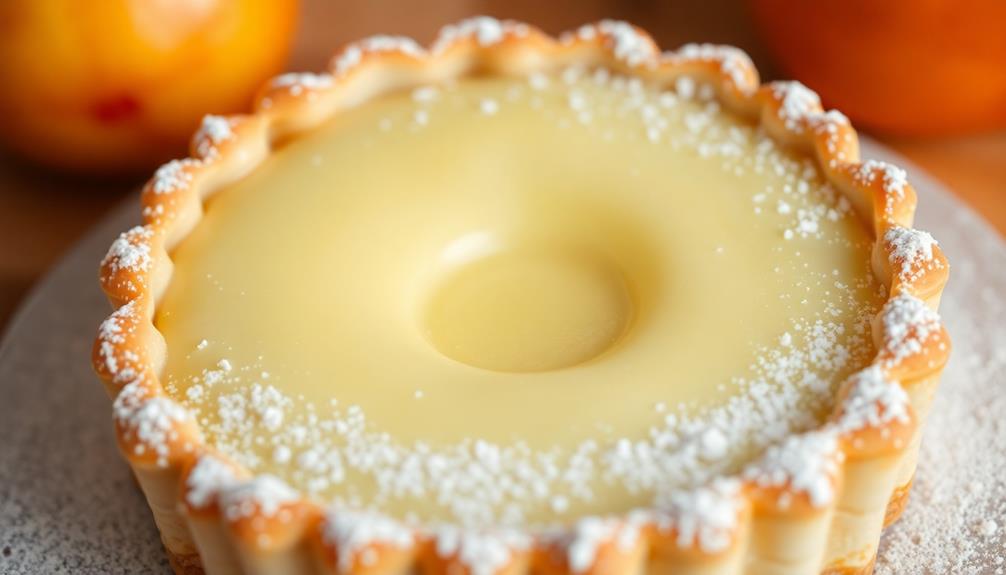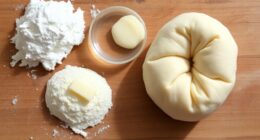To achieve feather-light cakes, you should sift your flour thoroughly using a fine mesh sieve or sifter just before mixing. This process breaks up clumps, aerates the flour, and guarantees even ingredient distribution. Store your flour properly in an airtight container in a cool, dry place to preserve its quality and make sifting easier. Mastering these techniques can transform your baked goods, so keep going to discover even more tips for perfect cakes.
Key Takeaways
- Use a fine-mesh sieve or sifter to aerate flour, breaking up clumps for a light cake texture.
- Sift flour just before mixing to maintain its fluffiness and prevent settling.
- Employ alternative methods like a strainer or electric sifter to save time during large batches.
- Store flour in an airtight container in a cool, dry place to preserve its sifting quality.
- Incorporate consistent sifting techniques into your baking routine for uniformly airy, tender cakes.
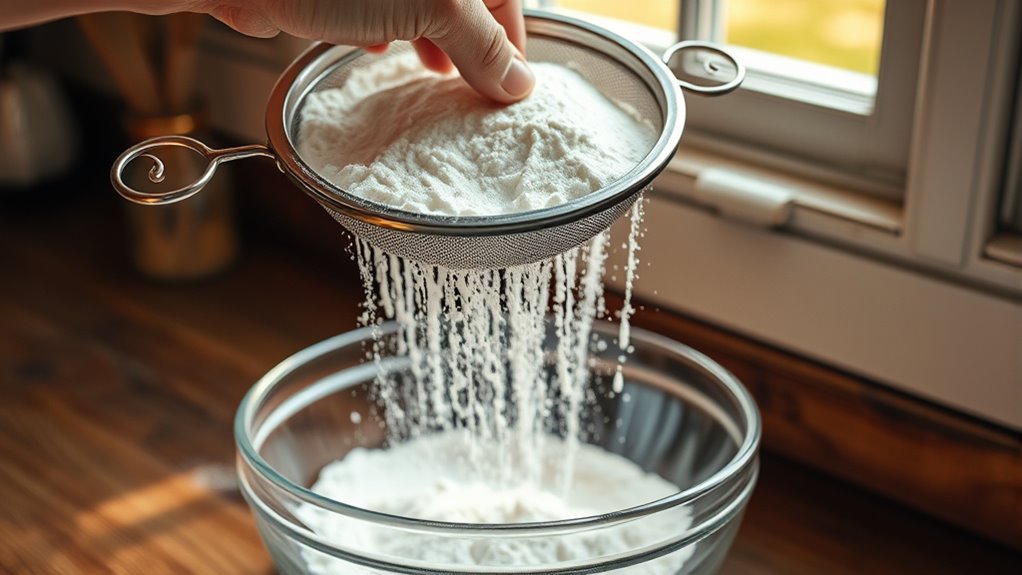
Sifting flour might seem like a small step, but it’s vital for baking light, airy cakes. When you sift flour, you break up clumps, aerate the powder, and guarantee an even distribution of ingredients. This creates a delicate texture in your final product, making your cakes fluffy and tender. While the traditional method involves passing flour through a fine mesh sieve using a spoon or a sifter, there are alternative sifting techniques that can save time and effort. For instance, you can use a fine-mesh strainer and tap it gently over your bowl, or employ an electric whisk or hand-held mixer to quickly aerate and mix your flour with other dry ingredients. These methods streamline the process, especially when you’re working with multiple ingredients or preparing large batches.
To get the most out of your sifting process, proper flour storage tips are vital. Store your flour in an airtight container in a cool, dry place to prevent moisture absorption and contamination. Keeping flour away from direct sunlight and heat sources helps preserve its freshness and prevents it from becoming rancid. If you buy flour in bulk, consider dividing it into smaller portions and freezing them; just make sure to bring it to room temperature before sifting to avoid clumping. Additionally, labeling your containers with the date of purchase ensures you use the oldest flour first, maintaining peak quality. Proper storage not only keeps your flour fresh but also makes sifting easier, as dry, well-preserved flour flows smoothly through your sifter or alternative tools, especially when proper storage practices are followed. Incorporating consistent sifting techniques into your baking routine can further enhance the lightness and texture of your cakes. Using the right storage methods also helps maintain the dryness of your flour, making the sifting process more efficient and effective.
When sifting, always use a clean, dry bowl to prevent any unwanted moisture from clumping the flour. If you prefer a faster or more efficient process, an electric sifter can do the work for you, quickly aerating the flour with minimal effort. Regardless of your chosen method, always sift your flour just before incorporating it into your batter to preserve its lightness and prevent settling or compaction. Additionally, understanding how AI safety measures are developed and monitored can help bakers stay informed about emerging technologies that could influence their baking tools. Remember, the key to achieving feather-light cakes lies not just in sifting but also in how you handle your flour before and after that step. Proper storage, clever alternative sifting techniques, and timely use of your sifted flour all contribute to the perfect, tender crumb you’re aiming for. With these tips, you’ll transform your baking routine and consistently produce cakes that are impressively light and fluffy.
Frequently Asked Questions
Can I Reuse Sifted Flour for Different Recipes?
You can reuse sifted flour for different recipes if you store it properly. After sifting, keep it in an airtight container in a cool, dry place to prevent moisture and pests. Reusing sifted flour is fine if it hasn’t been contaminated or exposed to humidity. Always check for any clumps or odd smells before using it again, and label it to avoid confusion with fresh flour.
How Does Altitude Affect Flour Sifting and Cake Lightness?
Altitude baking impacts flour aeration and cake lightness by reducing air pressure, which can cause baked goods to rise unevenly or collapse. When you sift flour at high altitudes, it helps incorporate more air, improving aeration and ensuring lighter textures. You might need to adjust your sifting and mixing techniques to compensate for these altitude effects, resulting in cakes that stay fluffy and well-risen despite the thinner air.
Is There a Preferred Sifting Method for Gluten-Free Flours?
When working with gluten-free alternatives, you should use gentle sifting techniques to prevent breaking delicate ingredients. Use a fine-mesh sieve and sift your flours multiple times to aerate them and make certain of even mixing. This helps avoid clumping and creates a lighter, more consistent batter. Incorporating these sifting techniques guarantees better texture and rise in your baked goods, especially since gluten-free flours often need extra care to achieve that feather-light quality.
How Do I Store Sifted Flour to Maintain Its Texture?
Did you know improperly stored flour can lose up to 50% of its freshness in just a few months? To keep your sifted flour’s light, airy texture, store it in an airtight container away from heat and moisture. Use cool, dark places like a pantry or cupboard. Follow these storage tips to guarantee your flour stays fresh and maintains its perfect texture for all your baking needs.
Can Sifting Flour Improve the Shelf Life of Baked Goods?
Sifting flour can slightly improve the shelf life of baked goods by removing clumps and incorporating air, leading to better texture. To maximize storage tips, keep sifted flour in an airtight container in a cool, dry place away from sunlight. This helps preserve freshness and prevents spoilage. While sifting alone doesn’t dramatically extend shelf life, proper storage combined with it ensures your baked goods stay lighter and fresher longer.
Conclusion
Sifting flour might seem like an extra step, but it’s your secret weapon for airy, delicate cakes. Think of it as giving your flour a quick spa treatment—fluffy and free of lumps. Picture pouring a mountain of sifted flour into your mixing bowl, instantly light and airy, ready to create those feather-light layers you love. Trust me, a little extra effort here transforms your baking from good to amazing every time.
